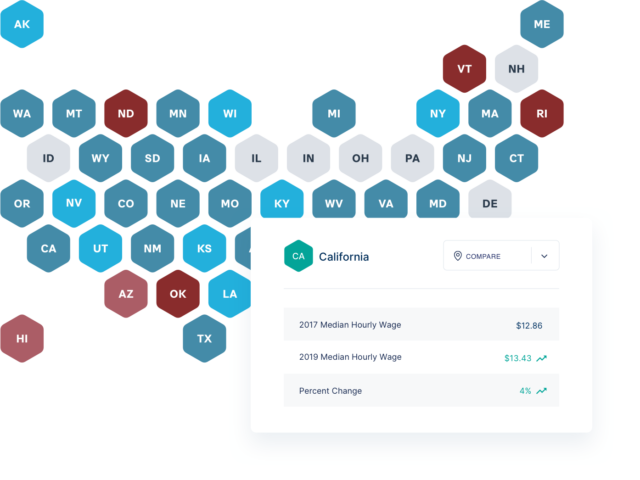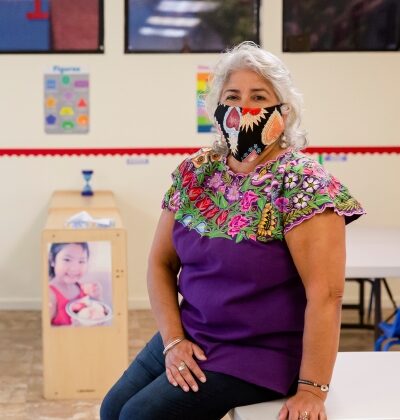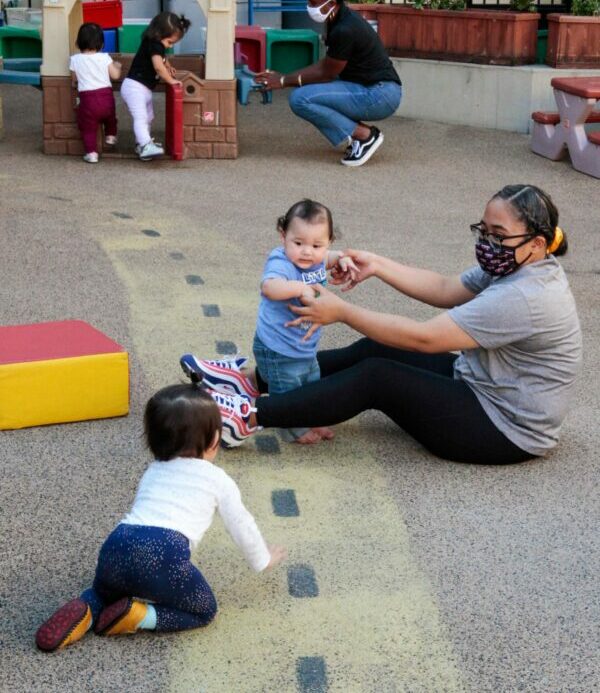Homepage – Early Childhood Workforce Index 2020
Early Childhood Workforce Index
The Early Childhood Workforce Index provides a state-by-state look at policies and conditions affecting the early care and education workforce. This biennial report has tracked state progress since 2016.

2020 Report
This third, 2020 edition of the Index continues to track state policies in essential areas like workforce qualifications, work environments, and compensation. The report provides updated policy recommendations and spotlights state responses to the COVID-19 pandemic.

State Explorer
The Early Childhood Workforce Index includes a profile for every state and the District of Columbia with detailed information on early educator wages and state policies. Compare the states and territories using the interactive mapping tool.

Supported By
The 2020 Early Childhood Workforce Index is generously supported by the Heising-Simons Foundation, the W.K. Kellogg Foundation, the Alliance for Early Success, the W. Clement & Jessie V. Stone Foundation, and the David and Lucile Packard Foundation.
FAQs
- What is the purpose of the Early Childhood Workforce Index?
Nationwide, the teachers and caregivers who make up the early childhood workforce are struggling to get by on low wages and face insufficient workplace supports. Without transforming policies that shape how we prepare, support, and pay early educators, the 21st-century goal of quality early learning opportunities for all children will remain elusive.
The Index provides state-level appraisals of early childhood workforce conditions and policies based on measurable indicators in order to encourage advocates and policymakers to step up their efforts to address persistent challenges facing the early childhood workforce. Subsequent iterations of the Index provide the opportunity to identify trends and track progress in the states over time.
- How often is the Index updated?
The Index is updated biennially. The next edition of the Index will be released in 2022, with subsequent iterations to follow every two years.
- Who is included in the early childhood workforce?
In the Index, when we speak to policies, programs, and financing for the early childhood workforce, we align our boundaries of the workforce with those articulated by the International Labor Office (ILO) and the United Nations Educational, Scientific and Cultural Organization (UNESCO) in the International Standard Classification of Education (ISCED). The ISCED defines early educators as those who are “responsible for learning, education, and care activities of young children” and working in programs that are “usually school-based or otherwise institutionalized for a group of children (for example, center-, community-, or home-based), excluding purely private family-based arrangements that may be purposeful but are not organized in a program (for example, care and informal learning provided by parents, relatives, friends, or domestic workers).”1International Labour Office, Sectorial Activities Department (2014). Meeting of Experts on Policy Guidelines on the Promotion of Decent Work for Early Childhood Education Personnel. Geneva, Switzerland: International Labor Office. Retrieved from https://www.ilo.org/wcmsp5/groups/public/—ed_dialogue/—sector/documents/normativeinstrument/wcms_236528.pdf.
We focus primarily on those who work in teaching and administrative roles in early care and education settings serving children prior to kindergarten. We also compare the status of early educators to those teaching older children in order to highlight disparities in working conditions for educators across the birth-to-age-eight spectrum of early childhood development.2Early childhood as a developmental stage of learning for children includes the period from birth to age eight. However, existing education systems, policy structures, and professional organizations are typically bifurcated between those working with children age five and under/prior to school age and those working in the school system K-3 grades (age five to eight). For more information, see Institute of Medicine (IOM) & National Research Council (NRC) (2015). Transforming the Workforce for Children Birth Through Age 8: A Unifying Foundation. Washington, DC: The National Academies Press. Retrieved from https://www.nap. edu/catalog/19401/transforming-the-workforce-for-children-birth-through-age-8-a.
A wide variety of terms are used to refer to the early care and education sector and its workforce depending on the age of children served (e.g., infants and toddlers, preschool-age children), the location of the service (centers, schools, or homes), auspice and funding streams, job roles, and data sources. We use “early childhood workforce” or “early educators” to encompass all those who work directly with young children for pay in early care and education settings in roles focused on teaching and caregiving. We use more specific labels, such as “Head Start teacher” or “home-based provider” when we are referring to a particular type of setting. In some cases, we are limited by the labels used in a particular data source. For example, in some instances, we refer to “childcare workers” and “preschool teachers” because we relied on data specific to subcategories of the workforce as defined and labeled by the Standard Occupational Classification of the U.S. Department of Labor.
- What’s the difference between child care workers and preschool teachers?
Child care workers and preschool teachers are occupational groupings defined by the U.S. Bureau of Labor Statistics (BLS) Standard Occupational Classification, which is used to classify all occupations in the United States for the purposes of federal data collection.
The BLS defines “childcare workers” as those who “attend to children at schools, businesses, private households, and childcare institutions” and “perform a variety of tasks, such as dressing, feeding, bathing, and overseeing play,” while “preschool teachers” are those who “instruct preschool children in activities designed to promote social, physical, and intellectual growth needed for primary school in preschool, day care center, or other child development facility.”
Preschool teachers are a more narrowly defined group of people working in school- or center-based facilities (not homes) with children before kindergarten, usually three- to four-year-olds. This group includes, but is not limited to, teachers working in publicly funded pre-K programs. “Child care workers” is more of a catchall term for people who are not classified as preschool teachers but who care for and educate children in home- and center-based settings while their parents are working. Child care workers may work with infants and toddlers, three- and four-year-olds, or school-age children. For the Occupational Employment Statistics (OES) used in the Index, neither of these categories include the self-employed nor do they include directors or other leadership. Directors are included under “Education Administrators, Preschool and Childcare Center/Program.”
These definitions do not adequately reflect distinctions in settings and roles among early educators, and as a result, there have been calls to revise the classifications. For more information, see: Workgroup on the Early Childhood Workforce and Professional Development (2016). Proposed Revisions to the Definitions for the Early Childhood Workforce in the Standard Occupational Classification: White paper commissioned by the Administration for Children and Families, U.S. Department of Health and Human Services (OPRE Report 2016-45). Washington, DC: Office of Planning, Research and Evaluation, Administration for Children and Families, U.S. Department of Health and Human Services.
- How is the Index making an impact?
The Index has helped to raise awareness of the conditions facing early educators. A media analysis by the David and Lucile Packard Foundation documented that the 2016 Early Childhood Workforce Index drove almost all of the media coverage about early educators that year, including via major media outlets such as The New York Times and PBS NewsHour. The Index continues to be cited regularly by media outlets such as The Hechinger Report and EdSurge.
Among state and federal advocacy groups, there has been a marked increase in awareness of the need to focus more on educators’ needs, in addition to those of children and families. The Index is regularly cited as a resource in state plans. Examples include:
- A report to the Washington state legislature on improving pay for early educators;
- Recommendations by a state-level advisory group in Minnesota for supporting the ECE workforce;
- A report by the California Assembly Blue Ribbon Commission on Early Childhood Education; and
- Colorado’s 2020 plan for the early childhood workforce.
The Index serves as a key resource for the early care and education field and beyond. Respondents to an online survey for the 2018 Index edition shared the following feedback:
- “[The Index] is the most accessible and complete source of information about the ECE workforce.”
- “The Index is something I use almost constantly in my work. Thank you for this great resource.”
- “The accessibility and ease of use of the materials [are the most useful part of the Index]. I am frequently sharing information with stakeholders and policymakers who may not be immersed in the child care world and who look to experts in the field to provide them with the necessary information to inform their policy and budget decisions for my department.”
- “The accompanying materials are easily digested by those who are outside of the field. I’ve brought these materials to my legislators, friends, and family, and they are all very approachable. I also love that the data are divided by state and comparable state-to-state.”
- “Thank you for this useful information. It has helped me make the case for additional funding for our children and employees.”
- “I am someone who relies on the information I get from CSCCE to support my advocacy and policy work…. I was successful in using data in reports to increase professional development funding for a citywide early learning pilot for family child care providers.”
See additional examples of how educators, advocates, and legislators have used the Early Childhood Workforce Index.
- What are the key findings from the 2020 Index?
Low pay and racial wage gaps
Economic insecurity is widespread among the ECE workforce, regardless of years of tenure in the field or higher education degrees. And little progress has been made since our 2018 Workforce Index. Early educators, especially the women of color who typically care for infants and toddlers, continue to earn less than $15 an hour and worry about where their next meal will come from.
As difficult as it is for anyone to be an early educator in America, our analysis shows it’s even harder for Black and Latina women, who face persistent wage gaps and belong to communities hardest hit by the COVID-19 pandemic.
Child care workers continue to be one of the lowest-paid occupations nationwide, with a national median wage of $11.65 an hour. They remain nearly at the bottom percentile of jobs ranked by annual pay, unchanged since CSCCE’s first 2016 Index.
- Poverty rates among early educators are seven to fourteen times higher than among public school teachers, depending on the state. In most states, wages fall short of the living wage for a single adult, from $0.13 short in Montana to as much as $3.39 less per hour in Hawaii.
- For a single adult with no children, median child care worker wages in only 10 states are equivalent to or more than the living wage for that state (Alaska, Arizona, Colorado, Maine, Minnesota, Nebraska, North Dakota, Vermont, Washington, and Wyoming).
- For a single adult with one child, median child care worker wages do not meet a living wage in any state, yet many early educators are themselves also parents.
Improvements in ECE workforce policies
Despite the complexity of their jobs and their critical role in children’s development and learning, efforts to prepare, support, and compensate early educators are persistently sidelined. The few bright spots of progress on state policies between 2018 and 2020 include:
- As pandemic crisis measures, a few states offered additional payments to early educators. They were the exception, and while useful, these bonus payments were not enough to keep many afloat.
- North Carolina and New Mexico provided early education staff with monthly bonus payments ranging from $350 to $950 per month.
- Kentucky issued a one-time $1,500 bonus payment to early educators providing services for families of essential workers.
- Wisconsin relaxed eligibility requirements for their pre-pandemic REWARD stipend initiative and granted awards to recipients who were furloughed or working reduced hours, as well as a one-time stipend increase in July 2020 to active stipend recipients.
- Vermont provided additional funding to child care programs that were ordered closed during April and May 2020; one of the requirements for receiving the additional funding was that staff pay must be maintained.
- Several states improved their standing with regard to salary parity for pre-K teachers (Hawaii, Nevada, New Jersey, and Rhode Island).
- The District of Columbia, Illinois, North Carolina, Oregon, Rhode Island, Vermont, and Washington have developed (but not required) compensation standards or guidelines for early educators beyond pre-K teachers. Thirteen additional states have convened advisory groups or task forces or made other plans to address this issue.
- Poverty rates among early educators are seven to fourteen times higher than among public school teachers, depending on the state. In most states, wages fall short of the living wage for a single adult, from $0.13 short in Montana to as much as $3.39 less per hour in Hawaii.
- What is the source of data for the 2020 Index?
There is no comprehensive, longitudinal data source for tracking the early childhood workforce in its entirety across the United States nor is there a single source of comprehensive information about early childhood workforce policies across all 50 states. The Index compiles information from a wide variety of sources, including:
- Wage and employment totals from the Occupational Employment Statistics (OES) survey;
- A joint analysis by the Center for the Study of Child Care Employment and the Economic Policy Institute of the American Community Survey that provides data on poverty rates and the pay penalty experienced by early childhood educators with bachelor’s degrees;
- 50-state databases and reports specific to the early childhood field, such as the National Institute for Early Education Research Preschool Yearbook and the Quality Rating and Improvement Systems Compendium;
- 50-state databases and reports on family and income support policies from research and policy organizations such as the National Women’s Law Center, the Economic Policy Institute, the Center for Law and Social Policy, the National Conference of State Legislatures, and the Kaiser Family Foundation;
- A cross-state review of early care and education agency websites;
- A cross-state verification by state representatives, including child care licensing/subsidy administrators, QRIS administrators, and registry administrators; and
- Unpublished data provided by the National Workforce Registry Alliance and the T.E.A.C.H. Early Childhood National Center.
For more detailed information on data sources, see Appendix 1: Data Sources & Methodology.
- What are your recommendations for improving early childhood workforce policy?
The Index outlines a number of concrete steps that policymakers and other stakeholders can take at the state and federal levels to ensure a high-quality, affordable early care and education system, included below. For a complete list of action items, see the Advocacy Toolkit.
COVID-19 Measures
As long as educators continue to work in emergency conditions in which they are risking their lives, states should immediately provide:
- Personal protective equipment (PPE) and sanitizing supplies educators need for themselves and for the children in their care;
- Free access to COVID-19 testing;
- Guaranteed paid sick leave if educators must quarantine because of a positive test or exposure to the virus or if they become symptomatic;
- Guaranteed health coverage for educators and family members in their household; and
- Guaranteed pay of no less than the locally assessed living wage.
Tackling Compensation
- Prioritize appropriate compensation — wages/salaries as well as benefits such as health insurance — as an essential component for rebuilding the early care and education system.
- Establish wage and benefit standards that: set the wage floor at the locally assessed living wage; account for job role, experience, and education levels; and calibrate up to parity with similarly qualified elementary school teachers.
- Dedicate sufficient public funding for all programs to meet wage and benefit standards. Require and monitor adherence to those standards as a condition of the funding.
- Collect data on early educator compensation in order to identify and remedy racial wage gaps and other pay inequities, such as lower pay for infant-toddler teachers.
- Clarify that financial relief initiatives (tax credits, stipends) are an interim strategy, not a long-term solution to achieve appropriate wages and benefits.
Ensuring Public Funding
- Identify the amount of public funding needed at the state level to ensure ECE access for all children and families as well as good jobs for educators.
- The values-based budget estimates developed by the Center for the Study of Child Care Employment (CSCCE) and the Economic Policy Institute (EPI) are a good starting point to understand likely costs at the state level.
- Commit to securing dedicated, sustainable funds to realize reforms.
- Support national proposals, such as a New Deal child care infrastructure investment, to increase the number and safety of community-based facilities.
- Prioritize ECE in state budgets in addition to or in the absence of increased federal funding.
- How do I find information on my state?
For a full breakdown of how your state measures up on each indicator, see our State Profiles.
- How does my state compare to other states?
The Early Childhood Workforce Index does not formally rank states because even those states making the most progress still have much work to do to improve early childhood jobs.
Rather than rank states from best to worst, we group states into three broad categories based on how well they are doing along a series of measurable indicators for state policies specific to the early childhood field as well as broader policies intended to support working families.
- Red represents stalled: the state has made limited or no progress.
- Yellow represents edging forward: the state has made partial progress.
- Green represents making headway: the state is taking action and advancing promising policies.
See our State Explorer to compare your state to other states for each policy area.
- Does the Index provide information on the U.S. territories?
The 2020 Index is the first edition to provide information on the territories of the United States.
The U.S. territories were included in CSCCE’s scan of early care and education agency websites and other background research, but planned interviews with territory representatives were not possible. The restrictions of the COVID-19 pandemic prevented more detailed information on workforce policies in the territories from being gathered or verified.
To view information on the territories, please see Early Educators in the U.S. Territories.
- Does the Index provide information at the city or county level?
The Index is a state-by-state assessment of early childhood employment conditions and policies. It does not systematically track or report policies and practices at the local level.
- How do I cite the Index?
2020
McLean, C., Austin, L.J.E., Whitebook, M., & Olson, K.L. (2021). Early Childhood Workforce Index – 2020. Berkeley, CA: Center for the Study of Child Care Employment, University of California, Berkeley. Retrieved from https://cscce.berkeley.edu/workforce-index-2020/.2018
Whitebook, M., McLean, C., Austin, L.J.E., & Edwards, B. (2018). Early Childhood Workforce Index – 2018. Berkeley, CA: Center for the Study of Child Care Employment, University of California, Berkeley. Retrieved from https://cscce.berkeley.edu/topic/early-childhood-workforce-index/2018/.2016
Whitebook, M., McLean, C., & Austin, L.J.E. (2016). Early Childhood Workforce Index – 2016. Berkeley, CA: Center for the Study of Child Care Employment, University of California, Berkeley. Retrieved from https://cscce.berkeley.edu/early-childhood-workforce-2016-index/.












